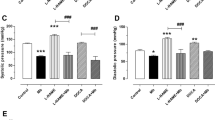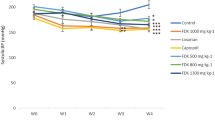Abstract
Introduction
Most available drugs used for management of hypertension have presented a plethora of challenges which genuinely called for development of therapies from natural sources.
Aim
This study investigated the effect of methanol extract of Adansonia digitata fruit (MEADF) pulp on NG-nitro-l-arginine methyl ester (l-NAME) induced hypertension in rats.
Methods
Fourty eight (48) wistar rats divided into six (6) groups (eight rats each) were employed. The induction of hypertension was achieved using l-NAME (40mg//kg body weight) by oral gavages. The induced rats were treated with MEADF pulp (200 and 400 mg/kg body weight) and Ramipril (10 mg/kg) and the remaining three groups serve as control. Serum haemodynamic and biochemical modifiable parameters were determined using standard assay procedures
Results
Administration of MEADF to the rats exerted a dose-dependent lowering effect on the elevated systolic blood pressure, diastolic blood pressure, mean arterial pressure and heart rate towards the normal physiological threshold. At 400 mg/kg of MEADF, there was significant (p < 0.05) reduction in serum lipid profile and biomarkers associated with endothelial dysfunction [angiotensin converting enzyme (ACE) activity], inflammation (C-reactive protein and interleukin-1β), oxidative stress (malondialdehyde) and cardiac injury (creatine kinase-MB and lactate dehydrogenase activities). However, serum concentrations of nitric oxide, high density lipoprotein cholesterol, total bilirubin and albumin were not significantly (p < 0.05) different from those found in normal control group.
Conclusion
This study therefore demonstrates that MEADF possesses an in vivo ACE inhibitory activity, hypotensive potential and the ability to avert further degeneration of biochemical and physiological upsets associated with l-NAME induced hypertension.





Similar content being viewed by others
References
Siyad AR. Hypertension. Hygeia J Drugs Med. 2011;3(1):1–16.
Giles TD, Materson BJ, Cohn JN, Kostis JB. Definition and classification of hypertension: an update. Emerg Concepts. 2009;11(11):611–4.
WHO. World health statistics. https://www.who.int/; 2015. Accessed 15 Sep 2020.
Steven VV, Hilda A, Samuel O, Ademola O, Charles A, Isabella A, et al. Status report on hypertension in Africa—consultative review for the 6th session of the African Union Conference of Ministers of Health on NCD’s. Pan Afr Med J. 2013;16:38.
Sena CM, Pereira AM, Seiça R. Endothelial dysfunction—a major mediator of diabetic vascular disease. Biochim Biophys Acta. 2013;1832:2216–31.
Mali VR, Mohan V, Bodhankar SL. Antihypertensive and cardioprotective effects of the Lagenariasiceraria fruit in NG-nitro-l-arginine methyl ester (l-NAME) induced hypertensive rats. Pharm Biol. 2012;50(11):1428–35.
Bilanda DC, Dzeuifiet PDD, Kouakep I, Aboubakar BFO, Tedong LK, Amtchouing P, et al. Bidenspilosa ethylene acetate extract can protect against L-NAME induced hypertension on rats. BMC Complement Altern Med. 2017;17:479.
Nguyen Q, Dominguez J, Nguyen L, Gullapalli N. Hypertension management: an update. Am Health Drug Benefits. 2010;3(1):47–56.
Chopra HK, Ram CVS. Recent guidelines for hypertension. Circ Res. 2019;124(7):984–6.
Balogun FO, Ashafa AOT. A review of plants used in South African traditional medicine for the management and treatment of hypertension. Plant Med. 2019;85:312–34.
Hussain ZTE, Yagi S, Mahomoodally MF, Mohammed I, Zengin G. A comparative study of different solvents and extraction techniques on the anti-oxidant and enzyme inhibitory activities of Adansonia digitata L. (Baobab) fruit pulp. South Afr J Bot. 2019;126:207–13.
Eltahir MES, Elsayed MEO. Adansonia digitata: phytochemical constituents, bioactive compounds, traditional and medicinal uses. In Mariod A, editor. Wild fruits: composition, nutritional value and products. Springer; 2019; pp. 133–142.
Kim KJ, Hwang ES, Kim MJ, Park JH, Kim DO. Antihypertensive effects of polyphenolic extract from Korean red pine (Pinusdensi flora Sieb. et Zucc.) bark in spontaneously hypertensive rats. Antioxidant 2020;9:333.
Sullivan V, Petersen K, Kris-Etherton P. Dried fruits and cardio-metabolic syndrome (endothelial function, inflammation, and blood pressure). Health Benefits Nuts Dried Fruits. 2020;413.
Ismail BB, Pu Y, Guo M, Ma X, Liu D. LC-MS/QTOF identification of phytochemicals and the effects of solvents on phenolic constituents and antioxidant activity of baobab (Adansonia digitata) fruit pulp. Food Chem. 2018;277:279–88.
Dragsted. Antioxidant actions of polyphenols in humans. Int J Vit Nutr Res. 2003;73(2):112–19.
Boots AW, Haenen GR, Bast A. Health effects of quercetin: from antioxidant to nutraceutical. Euro J Pharmacol. 2008;585:325–37.
Alhassan AJ, Muhammad IU, Jarumi IK, Wudil AM. Evaluation of anti-hyperlipidemic potentials of aqueous fruit pulp extract of Adensonia digitata in Experimental Rats. Euro Sci J. 2016;12(12):298–308.
Alrasheid AA, Ahmed SA, Eltilib SH, Alnour MI, Widdatallh MO, Fathi YassinL, et al. The effect of blending of extracts of Sudanese Adansonia digitata and Tamarindus indica on their antioxidant, anti-inflammatory and antimicrobial activities. J Pharmacog Phytother. 2019;11(2): 28–34.
Saravanaraj M, Muthusamy P, Radha R, Suresh AJ. Anti-diabetic effect of the ethanolic extract of dried fruits of Adansonia digitata Lin. W J Pharm Pharm Sci. 2017;6(5):1597–600.
OECD. Guidance Document on Acute Oral Toxicity. Environmental Health and Safety Monograph Series on Testing and Assessment; 2000. No. 24.
Ani CO, Francis AU, Chinemerem NC, Jide UU, Pamela OO, Augustine AO, et al. Investigation of antihypertensive effect of Nigerian varieties of Solanum lycopersicon on rats. Afr J Pharm Pharmacol. 2017;11(34):419–25.
Aguilar C, Graças M, Queir MN. Serum lipid profile and hepatic evaluation in mice fed diet containing pequinut or pulp (Caryocar brasiliense camb). Ciênc Tecnol Aliment Campinas. 2011;31(4):879–83.
Lieberman J. Elevation of serum angiotensin converting enzyme(ACE) levels in sarcoidosis. Am J Med. 1975;59(3):365–72.
Green LC, Wagner DA, Glogowski J, Skipper PL, Wishnok JSD, Tannenbaum SR. Analysis of nitrate, nitrite and 15N nitrate in biological fluids. Anal Biochem. 1982;126:131–8.
Singer JM, Piotz CM, Parker E, Elster SF. The latex-fixation test III. Agglutination test for C-reactive proteins and comparison with the capillary precipitin method. Am J Clin Pathol. 1975;28:611–7.
Ahmed HH, Abd El Dayem SM, AlyFoda FM, Farrag AH, Mohamed HA. Evolving concepts of depression provide new therapeutic options. J Chem Pharm Res. 2015;7(1):435–52.
Sabarathinam J, Selvaraj J, Devi S. Estimation of levels of glutathione peroxidase (Gpx), malondialdehyde (Mda), tumor necrosis factor alpha (Tnf alpha) and alpha feto protein (Afp) in saliva of potentially malignant disorders and oral squamous cell carcinoma. Biomed Pharmacol J. 2019;12(4):1881–6.
Dangerfield WG, Finlayson R. Estimation of bilirubin in serum. J Clin Pathol. 1953;6:173.
Tietz NW. Fundamentals of Clinical Chemistry. Philadelphia: W.B. Saunders Co.; 1987. p. 940.
Saha PK, Gupta I, Ganguly NK. Evaluation of serum creatine kinase as a diagnostic marker for tubal pregnancy, Australian and New Zealand. J Obstet Gynaecol. 1999;39:366–7.
Borghi C, Tsioufis K, Agabiti-Rosei E, Burnier M, Cicero AFG, Clement D, et al. Nutraceuticals and blood pressure control. J Hypertens. 2020;38(5):799–812.
Dalal J, Dasbiswas A, Sathyamurthy I, Maddury SR, Kerkar P, Bansal S, et al. Heart rate in hypertension: review and expert opinion. Int J Hypertens. 2019; 1–6.
Christofaro DGD, Casonatto J, Vanderlei LCM, Cucato GG, Dias RMR. Relationship between resting heart rate, blood pressure and pulse pressure in adolescents. Arqui Bras Cardiol. 2017;108(5):405–10.
Hropot M, Grotsch H, Klaus E, Langer KH, Linz W, Wiemer G, Sholkens BA. Ramiprilprevents the detrimental sequels of chronic NO synthase inhibition in rats: hypertension, cardiac hypertrophy and renal insufficiency. Arch Pharmacol. 1994;350:646–52.
Gulati A, Dalal J, Padmanabhan TNC, Jain P, Patil S, Vasnawala H. Lipitension: interplay between dyslipidemia and hypertension. Indian J Endocr Metab. 2012;16(2):240–5.
Elamin OF, Abdel Atti KA, Dalia AM. Effect of baobab (Adansonia digitata) pulp powder on serum lipid profile of rats fed high lipid diets. Pak J Nutr. 2019;18:1053–7.
Nyadjeu P, Nguelefack-Mbuyo EP, AtsamoAD, Nguelefack TB, Dongmo AB, Kamanyi A. Acute and chronic antihypertensive effects of Cinnamomum zeylanicum stem bark methanol extract in l-NAME-induced hypertensive rats. BioMed Central Complement Altern Med. 2013;13:27.
Hogg N, Zielonka J, Kalyanaraman B. Detection of nitric oxide and peroxynitrite in biological systems: a state-of-the-art review. In Nitric oxide 3rd ed. Elsevier; 2017; pp. 23–44.
Ramadan A, Harraz FM, El-Mougy SA. Anti-inflammatory, analgesic and antipyretic effects of the fruit pulp of Adansonia digitata. Fitoter. 1994;418–22.
Ghoneim MAM, Hassan AI, Mahmoud MG, Mohsen SA. Protective Effect of Adansonia digitata against Isoproterenol-Induced Myocardial Injury in Rats. Anim Biotechnol. 2016;27(2):84–95.
Author information
Authors and Affiliations
Corresponding author
Ethics declarations
Conflict of interest
The authors declare no conflict of interests
Funding
This study did not receive any specific grant from public, commercial and private sectors.
Author contributions
All the authors participated in the design and data collection. AAL carried out the laboratory experiments, analyzed the data and wrote the first draft of the manuscript; AS developed the concept of this study, analyzed the data and edited the manuscript and EO reviewed the relevant literature, analyzed the data and edited the manuscript. All authors have read and approved the content of this manuscript.
Rights and permissions
About this article
Cite this article
Liman, A.A., Salihu, A. & Onyike, E. Effect of Methanol Extract of Baobab (Adansonia digitata L.) Fruit Pulp on NG-Nitro-l-Arginine Methyl Ester (l-NAME) Induced Hypertension in Rats. High Blood Press Cardiovasc Prev 28, 291–300 (2021). https://doi.org/10.1007/s40292-021-00448-8
Received:
Accepted:
Published:
Issue Date:
DOI: https://doi.org/10.1007/s40292-021-00448-8




